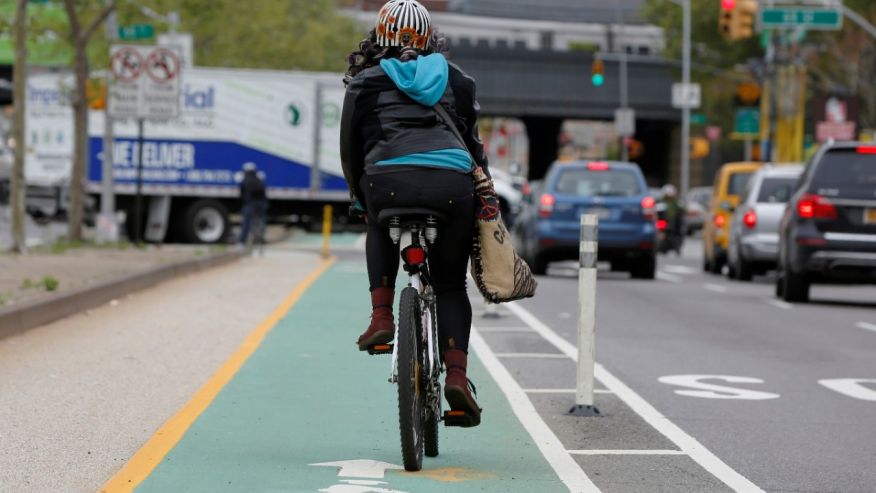Bike lanes are a sound public health investment

A woman rides a bicycle along a designated bike lane on Queens Boulevard in the borough of Queens in New York, U.S., May 5, 2016. (REUTERS/Shannon Stapleton)
Every $1,300 New York City invested in building bike lanes in 2015 provided benefits equivalent to one additional year of life at full health over the lifetime of all city residents, according to a new economic assessment.
That’s a better return on investment than some direct health treatments, like dialysis, which costs $129,000 for one quality-adjusted life year, or QALY, said coauthor Dr. Babak Mohit of the Mailman School of Public Health at Columbia University in New York.
Our greatest public health intervention, vaccines, take about $100 investment to yield one QALY, Mohit told Reuters Health by phone.
New York built 45.5 miles of bike lanes in 2015, with an investment of about $8 million. This increased the probability that residents would ride a bike by 9 percent, the researchers calculated.
Based on a population of 8.5 million, they compared the direct and indirect costs and benefits of building those additional miles of bike lanes versus maintaining the status quo before they were built.
Adding bike lanes to motor vehicle roadways reduces the risk of injury and raises the probability of ridership, which increases physical activity and decreases pollution from the vehicles riders would otherwise be using, they found.
Per person, bike lanes created an additional cost of $2.79 and a gain of .0022 quality-adjusted life years, according to the results published in Injury Prevention.
“For bike lanes the cost per QALY is $1,300, a little bit higher than vaccines but way lower than most medical interventions that we have in healthcare,” Mohit said. “We’re finding more and more of these social interventions are not directly medically related but have an extremely positive effect on giving us more life years.”
Bike lanes increase both recreational and commuter biking, he added.
“I definitely think there’s room for expansion of bike lanes, the city spends $67,000 per QALY for Medicaid and we think spending $1,300 per QALY buys you a lot more life for a lot less money,” Mohit said.
The data here is unique to New York, but even in some European cities where there are bike lanes on practically every street, researchers are still seeing additional benefit to adding bike lanes to more rural roads, he noted.
The authors also point out that their model can be adjusted by other cities to calculate the benefits of making bike riding easier in those communities.
The study did not distinguish between bike lanes, bikeways, shared-use paths and other bike facilities, said Anne Lusk, a research scientist at the Harvard T.H. Chan School of Public Health in Boston who was not part of the new study.
One study, cited by Mohit and coauthors, found that bike lanes made the city safer for drivers and pedestrians but less safe for bicyclists, Lusk told Reuters Health by email.
“In sum, I am glad to read the conclusion that bicycle facilities are a worthwhile health investment but saddened that the author did not clearly specify that the facilities built in NYC starting in 2007 were primarily Class IV cycle tracks (barrier-protected bicycle-exclusive paths beside sidewalks),” she said.
Painting unprotected bike lanes into roads may not reduce injury and death, she said.
“Once considered desirable because they were ‘low hanging fruit,’ we need to stop painting door zone bike lanes and start creating barrier protected cycle tracks,” Lusk said. Riding in the so-called door zone can be fatal if someone in a parked car opens their door at the wrong time, she said.
[“source-ndtv”]


